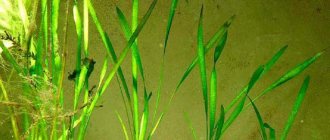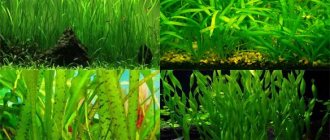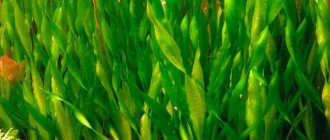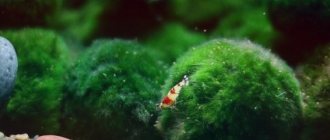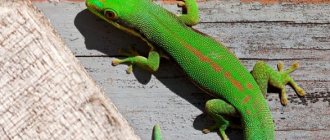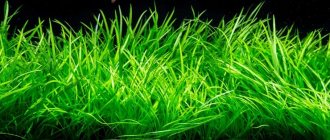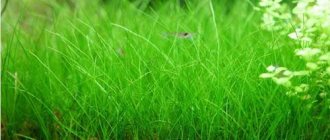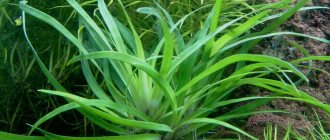Description
Vallisneria is a plant from the Aquiaceae family that is widespread throughout the world. Valisneria leaves are collected in a rosette, which is buried in the ground. The grass has beautiful thin leaves that grow upward, the color can be bright green or reddish. In the spiral variety, the leaves grow upward and curl beautifully into a spiral. The length of the leaves reaches 1 meter; when actively growing, they float on the surface of the water.
The greenery has strong and elastic leaves that do not attract aquarium fish. If the greens turn red, don't worry. In some species, the foliage turns red over time. The only danger is burrowing fish that dig up the roots, which leads to the death of the plant. With good lighting and sufficient exposure to sunlight, the plant produces beautiful inflorescences in the shape of small bells.
Types of Vallisneria are divided by color, shape, and type of leaves. In home aquariums, American, spiral, and giant Vallisneria are most often planted.
Vallisneria giant and spiral will be an excellent shelter for aquarium fish. The fish will hide behind wide leaves.
Vallisneria gigantea
This is the largest representative of the species, so it is rarely found in small home tanks. The leaves reach 1-2 meters in length, so the plant requires a lot of space. The color of the leaves is exclusively green, the shape is straight. For planting, nutrient soil measuring 3-4 mm is required. The thickness of the soil layer should be at least 8 cm. Recommended water parameters: 22-26 degrees. There are no other requirements for care, water parameters or fertilizing.
Vallisneria spiralis
The most common type of weed chosen by beginners. The plant has beautiful spirally twisted leaves growing upward. The length of the leaves reaches 50 cm in good light. For intensive growth, nutritious fine-grained soil with fractions of no more than 3 mm is required. The thickness of the soil layer should be 3-4 cm. For good growth, light of medium intensity is required. Temperature: 20-25 degrees. Once a week, change the water in the aquarium by 30%.
Diseases, their causes and growing tips
Inappropriate living conditions are the main factor causing diseases. We list possible problems and tell you how to avoid them:
- Vallisneria dissolves in the aquarium . “Cryptocoryne disease” is a consequence of non-compliance with many husbandry parameters. A significant disturbance in the biological balance in the aquarium can lead to such a negative phenomenon.
- Yellowing and dying of leaves occurs due to iron deficiency. Adding 0.1 mg of iron sulfate to the water once a week will correct the situation.
- Blackened leaf tips indicate boron deficiency. To eliminate it, add 0.2 mg/l boric acid.
- Yellowing of the leaf edges is due to a lack of nitrogen. To replenish its quantity, lower the water temperature for several days.
- Do the leaves turn red and the young shoots curl up and darken? This means they lack phosphorus. Fertilizing with phosphorus fertilizer will stop the process.
If the Vallisneria bushes produce dense growth, simply thin them out. Do not cut the leaves under any circumstances: this will destroy the plant.
When decorating an aquarium with Vallisneria, try to maintain optimal conditions for it. This unpretentious perennial will respond to your efforts with lush growth and beautiful forms.
Keeping in an aquarium
Vallisneria is a popular aquarium plant that adapts well to any environment. With sufficient light, the plant can be grown up to 70-80 cm in length. It is recommended to plant grass in small bushes in the background or side.
In order for the grass to grow and reproduce well, it is necessary to create optimal conditions for it:
- acidity: 5-7 pH;
- hardness: 7-8 dH;
- temperature: 18-30 degrees;
- lighting: bright, natural;
- soil: nutritious, sandy, silty, without fertilizing;
- carbon dioxide: not required.
Why doesn't Vallisneria grow?
Vallisneria is one of the most unpretentious aquarium plants, but it happens that it does not take root or grows poorly. This happens due to a number of factors that negatively affect plants:
- lack of lighting;
- cold water temperature - 15 °C or less;
- insufficient nutrient content, infrequent feeding;
- copper and rust content in water;
- too rare or frequent water changes, use of unsettled water;
- the presence of nearby plants with a powerful root system that reduce the nutrition of Vallisneria.
Soil and fertilizing
The composition of the soil does not matter much. An unpretentious aquarium plant, Vallisneria takes root well in any substrate. The ideal size of soil particles is 4-6 mm. The thickness of the soil layer should be about 4 cm. It is recommended to select a nutritious sand or gravel substrate.
The grass is fertilized from time to time. Specialized stores sell ready-made complex fertilizers in tablets or plates. No clay or peat is added to the soil; it is enough to feed in tablets.
Flowering and pruning
Vallisneria torsionifolia.
In aquariums, Vallisneria does not bloom too often, but under favorable conditions and sufficiently warm water (not lower than +25°C), the bush produces thread-like flower stalks, at the end of which there is a thickening. Rising above the water, the inflorescence is freed from the cover, and the white petals open. After flowering, the stem curls into a spring and pulls the inflorescence under water.
When Vallisneria grows too much on the surface and begins to shade the aquarium, you can trim it. At the same time, the largest bushes are removed from the reservoir, leaving daughter rosettes that have not yet reached the surface. You cannot trim the leaf blades, because they die. But from a short plant you can remove 1-2 leaves (yellowed, old or damaged).
Water parameters and temperature conditions
Vallisneria is unpretentious, so it develops well at any temperature. The water temperature in the aquarium varies within a wide range of 18-30 degrees. In cooler water the grass disappears. The plant does not like high concentrations of iron, so tap water is carefully left to settle before planting. Some fish medications contain a lot of metal, so read the ingredients carefully before using them.
Price
The price of Vallisneria depends on the type and size of the plant. On average, the cost of one bush up to 15 cm high is 40-70 rubles, a larger one - 200-300 rubles. Varieties with a more decorative appearance (spiral or striped leaves) are more expensive - from 350 to 700 rubles. The most expensive forms are those with red leaves - their cost can reach 2,500 rubles per bush.
Vallisneria is a beautiful and easy-to-keep species, suitable as a first plant for a beginning aquarist. It not only decorates an artificial pond, but also cleanses it of nitrates and other harmful organic compounds dissolved in water due to its high growth rate and consumption of large amounts of nutrients. When planted in a newly started aquarium, Vallisneria helps to more quickly establish biological balance in it.
If you liked the article or have something to add, leave your comments.
How to plant Vallisneria correctly
Sprouts should be planted in groups. This way they will look more interesting and noticeable. A single small plant is almost invisible in the tank against the background of other lush bushes. They are planted as a wall in the background of the tank or grass is planted in the center.
Experts recommend planting grass next to the filter mechanism. The current promotes uniform distribution of long leaves over the water surface.
The Vallisneria plant has long roots that quickly become fixed in the soil. The length of the roots reaches 10 cm. When planting, it is recommended to make a small hole in the ground where the grass is carefully placed. The hole with greenery is covered with soil. Small pebbles are placed on top to strengthen the grass.
Types and varieties of Vallisneria
Vallisneria Spiral - this variety of Vallisneria was one of the first to be discovered and got its name due to the ability of its peduncles to twist in the form of a spiral. The culture is a rosette consisting of linear leaf plates reaching a length of up to 80 centimeters. The edges of the leaf blades are finely serrated. The inflorescences are small. Before flowering, the peduncle floats to the surface, where pollination occurs, after which it again goes under water. The flowering time of the crop is mid-summer.
Vallisneria Americana - the plant consists of a mop of small, ribbon-shaped, long and soft leaf plates of light green color with a reddish tint. The height of the crop can reach up to 100 centimeters. At home it rarely blooms; in the wild the plant blooms in mid-summer.
Vallisneria gigantea - the height of the leaf plates can reach up to 2 meters and the width up to 4 centimeters. The leaves are dark green, growing in tufts with serrated edges. This algae can be used for large and tall aquariums and artificial ponds.
Vallisneria Nathans is an aquatic plant reaching a length of up to 100 centimeters. It can be grown in aquariums and artificial ponds. The crop has an underdeveloped, creeping root system and narrow, light green leaf blades with serrated edges. When grown in an aquarium it does not bloom; in a pond it blooms in mid-summer.
Editorial: Berlin Swordtail
Vallisneria tigris
This variety of culture can reach a length of up to 1 meter. The leaf blades have a light green tint with small transverse stripes and black dots. Thanks to its decorative variegated colors, the plant received its name “Vallisneria tiger”.
Vallisneria torsionum - in the wild, this plant species grows in Vietnam, Central Asia and Japan. The culture has dark green leaf blades, the length of which is about 40 centimeters. They have a spiral shape and edges with frequent serrations. The growing season of Vallisneria lasts throughout the year. When grown in an aquarium, it rarely blooms and does not produce seeds.
Vallisneria Asiatica - the culture reaches 50 centimeters in length, and the diameter of the algae is up to 10 centimeters. It has fragile, spiral-shaped leaf plates of bright green color and a powerful root system. The plant requires good lighting for normal development.
Vallisneria vulgaris is the most common aquarium culture. It has long, bright green, ribbon-shaped leaf blades twisted in a spiral. The height of the crop reaches up to 80 centimeters. The plant has several varieties, differing from each other in height, shade of leaves and degree of curl. The root system is strong, thin and long, milky yellow in color.
Vallisneria Leopard
It has long, straight, bright green leaves reaching a height of up to 70 centimeters. While the leaf mass is young, it has a green tint, but as soon as the plant is a little over a year old, streaks of brownish color, reminiscent of leopard spotting, begin to appear on the leaves. In aquarium conditions, the culture does not bloom or bear fruit.
Vallisneria dwarf is a dwarf variety with thin dark green leaf blades reaching a length of up to 50 centimeters. The measles system is thin, flexible, durable. The plant loves light very much, so it should be planted in the center of the aquarium so that other algae do not shade it.
Vallisneria floating - the plant reaches a height of up to 70 centimeters and has narrow, ribbon-shaped leaf plates of a bright green hue. The algae has no stem; the leaves grow from the roots. Reproduction occurs by lateral shoots.
Vallisneria Red - the culture has a compact, creeping root system and linear leaf blades with finely serrated edges, reaching a height of up to 1 meter. The color of the leaf blades depends on the light intensity and can be either green or light green near the roots and red-brown at the ends. When domesticated, the plant does not bloom.
How to care for Vallisneria
With intensive growth, the leaves fill the entire water surface, so experts recommend thinning the grass. You cannot cut the leaves, as this will cause the plant to rot, turn yellow and look sloppy. It is recommended to thin out the grass if the leaves completely cover the water surface and prevent the penetration of light. The plant is thinned out by pulling out excess shoots, but the foliage cannot be trimmed.
If Vallisneria is not growing, check the water parameters and light intensity. Grass grows well only in clean water, so it is necessary to do 30% water changes weekly.
American
It is a large bush with ribbon-shaped leaves. They have low rigidity and serrated edges. They have a basic green color, but there is a reddish tint. The width is standard, 1-2.5 cm, the length varies from 80 to 100 cm. This variety is also called “aquarium wallpaper” because they are planted at the back wall, and soon they form a continuous wall of green thickets. Today there are several varieties of American Vallisneria on the market, but the “twisted-leaved” one is especially valued, since its leaves are 5 cm wide, and from the very base they curl, forming very beautiful thickets;
Reproduction
The grass reproduces vegetatively. New shoots appear at the base of the mother. The antennae are attached at a distance of 7-10 cm from the mother. Under good conditions, the vegetation produces many new shoots that grow in a cascade. Vallisneria produces about 50 new shoots per year. New shoots are carefully removed from the mother and planted separately.
An aquarium with Vallisneria looks beautiful and well-groomed. Beginners will not have to spend a lot of time caring for Vallisneria. Vallisneria does not grow in neutral soil without fertilizers, or in contaminated water. If the foliage turns yellow, it is necessary to replenish the soil with fertilizers and change the water. It is recommended to check whether the roots are fixed in the ground. The plant cannot be trimmed.
Appearance
Vallisneria is native to Northern Australia. This plant belongs to the perennial category. It has a short and poorly developed rhizome, the length of which does not exceed 10 cm. It is characterized by the presence of narrow, long and smooth leaves, reminiscent of variegated ribbons in their appearance.
It is recommended to plant the plant near the back walls. The leaf blades are distinguished by a rich emerald green color, but in some cases they can change their color to reddish or brown shades.
Despite the fact that Vallisneria belongs to the category of flowering plants, its inflorescences do not have decorative value, since they are small and not very attractive. The plant reproduces mainly by vegetative means, as well as with the help of lateral shoots.
There are a number of varieties of Vallisneria, each of which has its own special features regarding both appearance and conditions of detention.
Gigantic
A large plant whose leaf height can exceed 2 m. The plant has a rich green color and creates natural shading. This variety of Vallisneria is suitable for large aquariums, and it is recommended to plant it in the corners near the rear walls of the vessel.
The plant adapts well to different types of soil and changes in temperature conditions. But for full growth and development, it needs bright lighting for at least 12 hours a day. The best habitat for giant vallisneria is soft, slightly acidified water.
American
A very beautiful and spectacular plant with soft ribbon-like leaf plates. It can reach a height of 90-100 cm. The leaves have a double color, which is a combination of green and reddish shades. The American twisted-leaved Vallisneria is especially impressive for aquarium decoration, the leaves of which form a beautiful twisted spiral.
To create optimal conditions, the plant requires additional side lighting. Its small size allows this variety of Vallisneria to be used to decorate both the foreground and background of an aquarium.
Spiral
This subspecies is especially loved by aquarists for the ability of the peduncle to curl into a spiral, which looks very beautiful in an aquatic environment. The size of spiral vallisneria is relatively small - no more than 80 cm. The plant needs bright natural light. The optimal daylight hours are approximately 15 hours a day.
In winter, additional lighting is required, because otherwise the leaf blades of spiral Vallisneria lose their beauty, turn pale, thin out, and acquire an unhealthy yellowish color.
Nana
This variety of Vallisneria differs from others in its particularly thin leaf plates of a dark green color, reminiscent of hairs in appearance. A characteristic feature of Vallisneria nana is also its compactness, because the height of the foliage does not exceed 35 cm.
Thanks to this feature, the plant can be used to decorate even small aquariums and planted in the foreground. The optimal environment for growing this variety is clay soil. The plant also needs additional moderate lighting.
Tiger
This crop has a characteristic variegated coloring, which has a clear resemblance to a tiger skin, in honor of which the plant deserves its name. This variety is compact, small in size, and unpretentious in terms of care, which is why tiger vallisneria has gained immense popularity among aquarists. Most often, the plant is planted on the sides of the container in order to create a spectacular background for decorative fish.
Neotropicalis
A beautiful aquarium plant with straight leaves. The leaves of Vallisneria neotropicalis can have different colors, which, depending on the conditions of detention, vary from green to brown and red shades. A large subspecies that is suitable for growing and decorating only in large aquariums.
Nathans
One of the most popular varieties of American Vallisneria. This plant is characterized by thin and narrow leaf blades of a bright green color, the length of which can reach 100 cm.
Aquarists prefer to plant Nathans near the back and side walls for decorative purposes. This culture is valued by users for its increased ability to saturate water with oxygen and normalize metabolic processes.
Neighborhood with other inhabitants of the aquarium
When planting Vallisneria in an aquarium, you need to understand that it should not grow alone in it. Therefore, growing conditions must be suitable for other inhabitants of the reservoir. Many aquarists are confident that this plant can get along with almost all other types of vegetation.
Vallisneria gigantea gets along well with other aquatic plants.
“Good” neighbors include:
- Hornwort.
- Water fern.
- Hygrophile.
- Water cabbage.
- Java moss.
There are also several unfavorable neighbors:
- Nymphea.
- Cabomba.
- Cirrus.
- Geranthera.
- Limnophila.
- Barclay.
Speaking of fish, almost every species can live normally in the vicinity of Vallisneria without interfering with the plant in any way. However, cichlids, despite the toughness of the leaves, can begin to eat the foliage.
[adsp-pro-7]
Maintenance and care
In nature, Vallisneria most often grows in hard water, very rarely in soft and acidic water. It is usually found in shallow waters where CO2 levels are low, so adding carbon dioxide to the aquarium is not required.
After planting the giant Vallisneria, it usually takes 2-4 weeks to acclimatize, after which the plant quickly grows and fills the aquarium. Vallisnia grows very quickly, about 1 cm per day. The leaves of the plant should not break, otherwise the leaf will completely die. Vallisneria leaves can only be cut with very sharp scissors so that they do not die. Dying leaves can also be cut off at the base with scissors.
Vallisneria is not very demanding; water hardness and pH level are not vital factors for it, but the plant prefers alkaline water. Vallisneria does not like currents or running water, so the plant should be located away from the filter or duct.
Vallisneria gigantea can withstand a fairly wide range of water temperatures, from 20 to 28 °C.
Lighting preferably has a full light spectrum. The brighter and stronger the light, the faster Vallisneria will grow.
As a soil, Vallisneria gianta prefers fine sand or fine rounded gravel with an average level of light. Iron is very important for this plant, and the best way to meet the need is to use a substrate rich in iron or add additional iron to the soil in the form of iron clay balls.
When planting Vallisneria, be careful; the leaves should always remain on the surface of the soil.
To stimulate plant growth, regularly apply liquid macro fertilizers and iron.
Economic use
At the Perm State Technical University, experimental studies were carried out that confirmed the possibility of using higher aquatic plants in the process of biological treatment of urban wastewater to reduce the content of nitrogen and phosphorus salts in them. It has been established that as a result of the use of the plant Vallisneria spiralis L. in the tertiary settling tank of treatment devices at a biomass density of 7 g/dm³, a contact time of 240 minutes and a wastewater flow rate of 6 m³/day per 1 m³ of structures, the maximum efficiency of removal from wastewater is: ammonium nitrogen - 66 %, nitrate nitrogen - 34%, nitrite nitrogen - 27.0%, phosphates - 41.0%.
